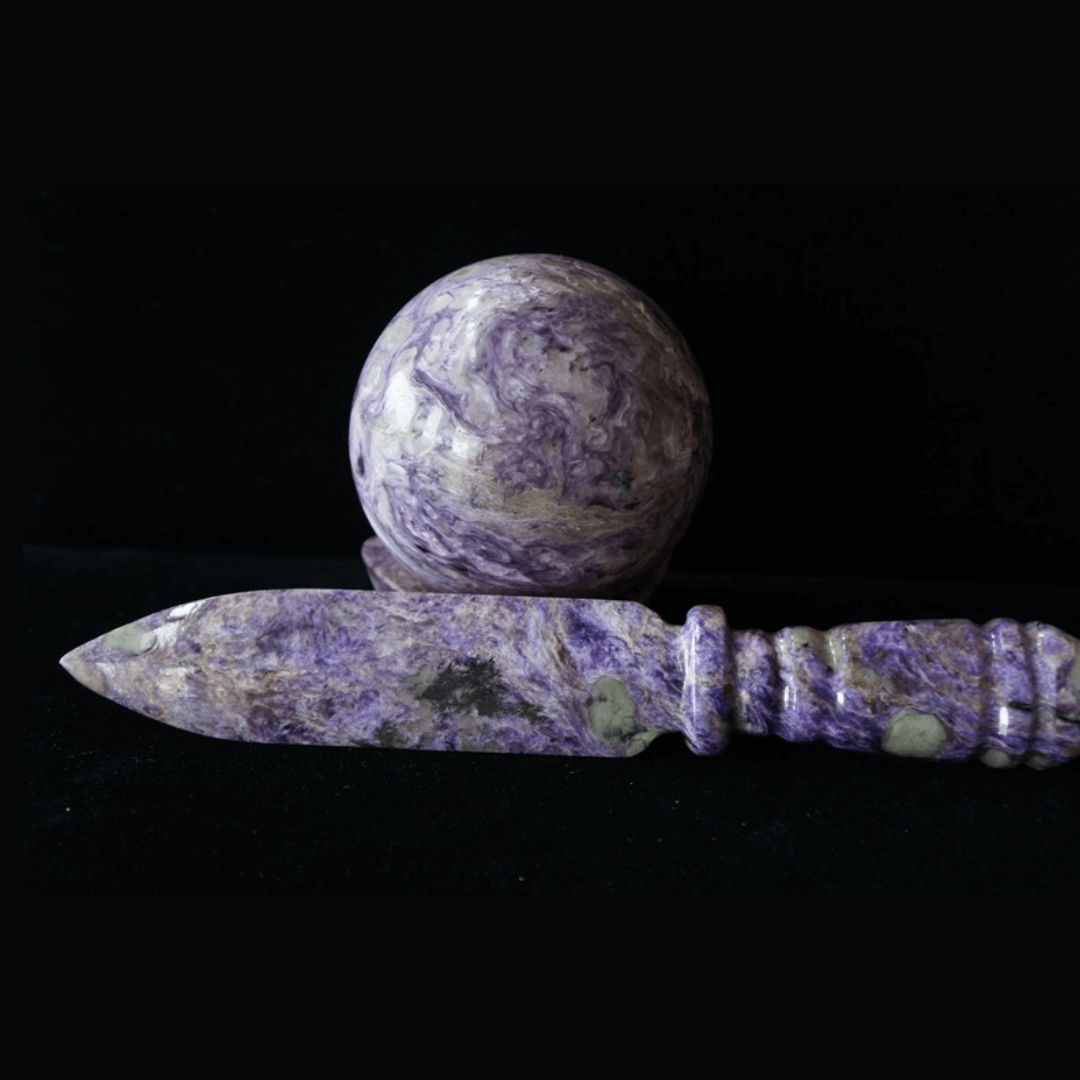|
I |
n recent years, we find that jewelry fashion colors are influenced by fashion color trends in clothing, textiles, furniture and home décor. The ideas flow from the runways to the stores. A driving engine for this movement has been the Pantone® Color Institute, Inc., recognized for a proprietary color system used in a variety of industries.
Violet is a spectral color at the end of the visible spectrum between blue and the invisible ultraviolet. Violet hues cover shades of mauve, purple, magenta, crimson, indigo, lilac, plum, amethyst, and lavender, depending on the ratio amounts of blue and red, and the lighter or darker tones.
Amethyst is the most classic representation for violet color since ancient times, but charoite, along with sugilite, purple sapphire, lavender jade, tanzanite, iolite, kunzite, fluorite, lavender chalcedony, black opal with purple flash, tiffany stone, and the more recent Mohave purple turquoise (natural turquoise, compressed, stabilized and dyed purple with bronze infusion) fill today the top spots for purple gems. Expanding into the pink-lilac-raspberry tones, we have purple garnet, spinel, tourmaline, zircon, scapolite, lepidolite, rhodonite, rhodochrosite, and Colorado’s unique astorite — the rhodonite-based material laced with chalcedony and gold and silver tendrils — completing the violet-to-pink spectrum.
One thing I love reading on Pantone’s website (www.pantone.com) is the sophisticated names of the chosen colors along with their concise but elaborate descriptions. The color names exude a luxury feeling, an exotic or natural sentiment that may add some poetic sensation to our jewelry artwork. Designers can find inspiration for new designs within those few words or matches to their already created artwork. The description for the ultraviolet color takes us into the mysteries of the cosmos and beyond, calling it an “enigmatic purple shade that evokes the inventive spirit and imaginative thinking that challenges the status quo.”
I have an extensive inventory of charoite compiled by purchases over the past twenty years, which we sell as slabs at our booths at gem shows. I have carved charoite and utilized it as part of my gem sculptures, but have not used much charoite in my jewelry. Recently I cut a few cabochons and drilled them for pendants, especially a flat rectangular piece of charoite that featured a natural, almost geometric pattern dividing the stone into purple charoite on the left and golden tinaksite on the right — one of the associate minerals that charoite occurs with. Unique patterns always attract my attention, and I love making them focal pieces of my jewelry.
Charoite is a rare silicate mineral with chemical formula K(Ca,Na)2Si4O10(OH,F). It displays a deep lilac-violet or lavender to purple color. Charoite occurs only in massive form, not as crystals. It is named after the place of its discovery, at the Murunskii Massif, at the confluence of the Chara River and the Tokko River in the Sakha Republic, Yakutia, of Eastern Siberia, in Russia, and it is a singular charoite deposit in the world. It is also said that the name charoite has come from the Russian word “chary” meaning charms or magic, in reference to the mineral’s iridescence appeal.
Ironically, the much-sought-after charoite of today, when it was first discovered in the 1940s while constructing a rail tunnel, was considered dark and unattractive and was misidentified as lilac cummingtonite. Soon after 1962, it was called Sirenyevyi Kamen (lilac stone), but it was not known to the outside world until its description in 1978 (Charoite, a new mineral and a new jewelry stone, Rogova, V.P., Y.G. Rogov, V.A. Drits, and N.N. Kutnetsova, 1978).
Charoite at its best is highly translucent, with beautiful swirling patterns of various shades of violet. White, fibrous, asbestos-charoite bands display a silky chatoyancy — a cat’s eye effect — and a pearly luster. The purple color is attributed to the coexistence of manganese and iron (Mn3+ and Fe3+). When charoite is iron rich and manganese poor, it has a more brown coloration, not as desirable on the market as the violet type. Specific gravity is 2.68 and refractive index 1.55.
Charoite occurs along with other minerals in altered limestone deposits creating a rock more accurately called charoitite. Associate minerals are canasite and carbonates, quartz, pale green microcline feldspar, dark green to black star-shaped sprays of aegirine-augite, golden chatoyant blades of tinaksite, sphene, and raspberry-red fedorite. Occasionally, flower-like patterns of mineral inclusions may appear in high-grade charoite when the cutting orientation is changed.
A distinct variety, known as “flower charoite,” articulates the rich visual patterns of a complex combination of the above-listed associate minerals, reminiscent of a painter’s brush strokes, or delicate crown stems of flowers. The ingredients may vary in each piece, even in every slab cut from a larger piece of rough, as one pattern fades and another one emerges. Although it was considered a “lower grade” when we purchased it over a decade ago, personally I think that “flower charoite” has a beautiful, very unique and visually ornate look.
The distinctive interlocking, fibrous texture of charoite can at times be problematic for the lapidary. Correct orientation (parallel to the banding) and slow cutting is often paramount to avoid flaking, shredding or splintering tendencies, which can be frustrating while cutting charoite, especially during the later stages of sanding, close to finishing and polishing. The hardness is Mohs 5-6, not too hard, and the cut gemstones take a great polish, best with diamond all the way. Cabochons with beautiful swirling patterns, chrysanthemum and flower patterns, and scenic landscapes, are most desirable. Besides cabochons and beads, charoite is often cut into spheres, eggs, and other decorative items, such as daggers, vases, bowls, and boxes.
I enjoyed staying for a while in my “purple zone,” matching beautiful bright 9mm round charoite beads with a pendant of purple botryoidal chalcedony from the Bradshaw Mountains near Prescott in northern Arizona, and featuring other purple gems in my jewelry. I also chose to wire wrap some of my pendants with rose gold wire, whose warm rose tones are another big trend now.



